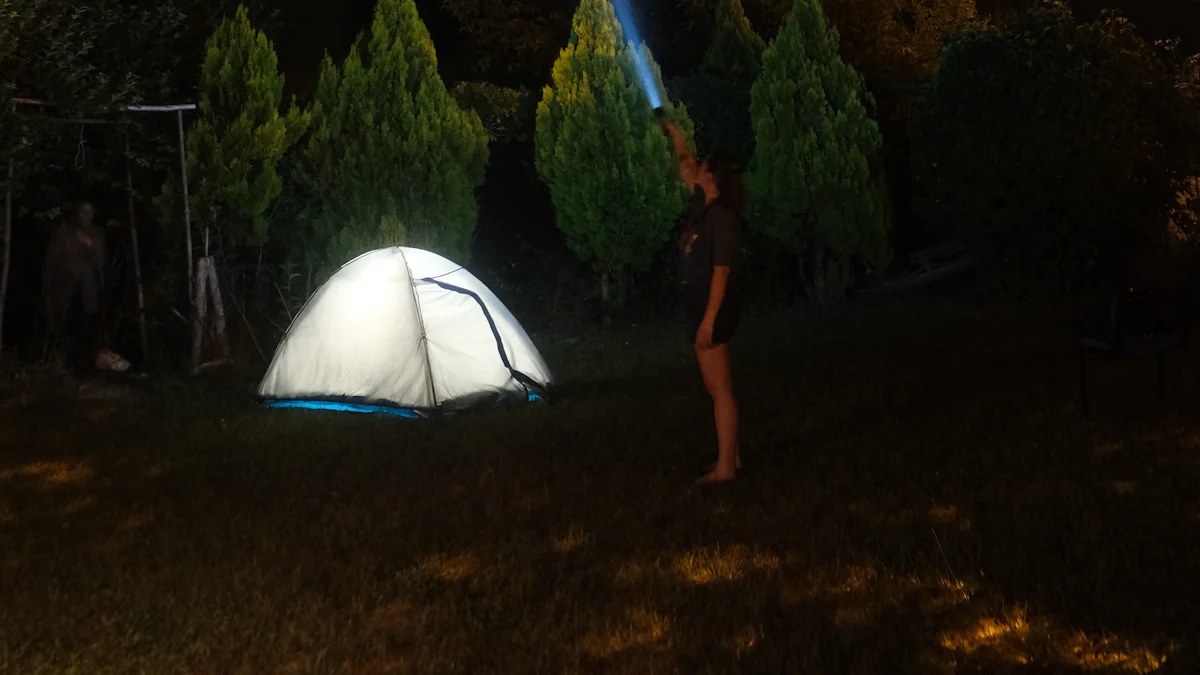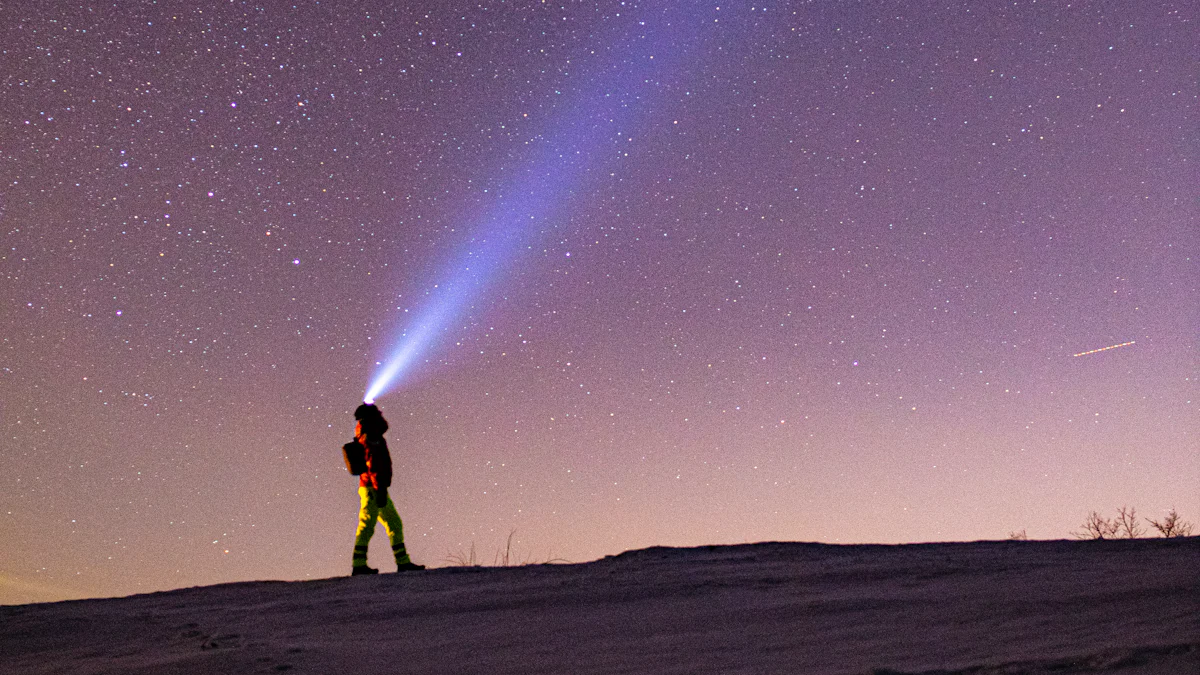Choosing the perfect outdoor LED flashlight is essential for safety and ease during outdoor adventures. A dependable option, such as the rechargeable P50 LED flashlights, delivers reliable brightness in dim environments. Products like the high power LED aluminum flashlight or the new aluminum zoomable AAA LED flashlight are designed to elevate activities like hiking, camping, or biking with their durability and adaptability. Whether you need an outdoor led flashlight for versatility or a high-performance outdoor led flashlight for rugged use, these options have you covered.
Key Takeaways
- LED flashlights save energy and work longer than old bulbs. They are great for outdoor trips.
- Think about how bright the light is and the beam shape. Pick one that fits your outdoor needs.
- Strong and weatherproof flashlights are important. They work well in tough weather.
Understanding Outdoor LED Flashlights

Benefits of LED Technology
LED technology has revolutionized the flashlight industry. These lights consume less energy compared to traditional incandescent bulbs, making them highly efficient. They produce brighter light while generating minimal heat, which enhances their longevity. Many LED flashlights can last tens of thousands of hours, reducing the need for frequent replacements. This durability makes them a reliable choice for outdoor enthusiasts.
Another advantage lies in their compact size. LEDs are small yet powerful, allowing manufacturers to design lightweight and portable flashlights. Additionally, LED lights are environmentally friendly. They do not contain harmful substances like mercury, making them safer for both users and the planet.
Key Features of Outdoor LED Flashlights
Outdoor LED flashlights come equipped with features tailored for rugged environments. Many models offer adjustable brightness levels, allowing users to conserve battery life or illuminate large areas. Some flashlights include zoomable beams, which provide flexibility for both wide and focused lighting.
Durability is another critical feature. High-quality outdoor LED flashlights often use materials like aluminum, which resist impact and corrosion. Waterproof and weather-resistant designs ensure functionality in rain or extreme conditions. Rechargeable batteries or dual power options add convenience, especially for extended outdoor trips.
Why LED Flashlights Are Ideal for Outdoor Use
LED flashlights excel in outdoor settings due to their reliability and performance. Their bright and consistent light output ensures visibility during nighttime activities. Long battery life reduces the risk of running out of power in remote areas. Lightweight designs make them easy to carry during hikes or camping trips.
These flashlights also withstand harsh conditions. Whether exposed to rain, dust, or accidental drops, they continue to function effectively. Their versatility suits various outdoor activities, from hiking to biking, making them an essential tool for adventurers.
Key Factors to Consider
Brightness and Lumens
Brightness determines how well a flashlight illuminates an area. Lumens measure the total light output. A higher lumen count means brighter light, but it may also drain the battery faster. For outdoor activities, flashlights with 200 to 600 lumens work well for general use. Those engaging in specialized tasks like search-and-rescue may need models with over 1,000 lumens. Always match the brightness level to the activity to avoid unnecessary energy consumption.
Beam Type and Distance
Beam type affects how light spreads. Flashlights typically offer flood beams, spot beams, or adjustable options. Flood beams provide wide coverage, ideal for camping or close-range tasks. Spot beams focus light into a narrow, long-distance beam, suitable for hiking or navigation. Beam distance, measured in meters, indicates how far the light reaches. Outdoor enthusiasts should consider both beam type and distance to ensure optimal visibility.
Battery Life and Power Options
Battery life plays a crucial role in flashlight performance. Rechargeable batteries reduce waste and save money over time. Some flashlights also support disposable batteries, offering flexibility during extended trips. Models with multiple power modes, such as low, medium, and high, allow users to conserve energy when needed. Checking battery life specifications ensures the flashlight lasts throughout outdoor adventures.
Durability and Weather Resistance
Outdoor environments demand durable flashlights. Materials like aircraft-grade aluminum provide impact resistance, while rubberized components enhance grip. Weather resistance, rated by the IPX system, ensures functionality in rain or dusty conditions. For example, an IPX4 rating protects against splashes, while IPX8 allows submersion in water. A durable outdoor LED flashlight withstands harsh conditions and ensures reliability.
Size, Weight, and Portability
Compact and lightweight flashlights are easier to carry during outdoor activities. Backpackers often prefer models that fit in a pocket or attach to gear. However, smaller flashlights may compromise on brightness or battery life. Balancing size and functionality ensures the flashlight meets specific needs without adding unnecessary bulk.
Budget and Value for Money
Flashlights vary widely in price. Budget-friendly options often provide basic features, while premium models include advanced technology like programmable modes or extended battery life. Buyers should assess their needs and compare features to find the best value. Investing in a reliable outdoor LED flashlight ensures long-term satisfaction and performance.
Choosing Flashlights for Specific Activities

Hiking and Backpacking
Hikers and backpackers need flashlights that balance brightness, weight, and battery life. Compact models with 200 to 400 lumens work well for illuminating trails without adding unnecessary bulk. Adjustable beams allow users to switch between wide and focused lighting, which is helpful for navigating uneven terrain. Rechargeable options reduce the need to carry extra batteries, making them ideal for multi-day trips. A lightweight outdoor led flashlight with weather resistance ensures reliability in changing conditions.
Camping and Overnight Adventures
Campers benefit from flashlights that provide both area lighting and focused beams. Models with multiple brightness settings help conserve battery life while offering flexibility for different tasks. A flashlight with a flood beam can illuminate a campsite, while a spot beam works well for nighttime walks. Durability is essential, as camping gear often faces rough handling. Waterproof designs protect against unexpected rain, ensuring the flashlight remains functional throughout the trip.
Biking and Night Riding
Cyclists require flashlights that mount securely to handlebars and provide consistent brightness. A model with at least 500 lumens ensures visibility on dark roads or trails. Flashlights with strobe modes enhance safety by making riders more noticeable to others. Rechargeable batteries are convenient for frequent use, while lightweight designs prevent added strain on the bike. Weather-resistant features ensure performance during sudden weather changes.
Hunting and Tactical Use
Hunters and tactical users need flashlights with high brightness and rugged construction. Models with 800 lumens or more provide excellent visibility in low-light environments. Red or green light modes help preserve night vision, which is crucial for tracking game. Tactical flashlights often include features like strike bezels or tail switches for quick operation. Durable materials and waterproof ratings ensure these flashlights withstand harsh outdoor conditions.
Tips for Maintenance and Care
Cleaning and Proper Storage
Regular cleaning keeps a flashlight in optimal condition. Dust and debris can accumulate on the lens and body, reducing light output and performance. Use a soft, lint-free cloth to wipe the exterior. For stubborn dirt, dampen the cloth slightly with water. Avoid using harsh chemicals, as they may damage the flashlight’s finish. Clean the lens gently to prevent scratches.
Proper storage extends the lifespan of a flashlight. Store it in a cool, dry place away from direct sunlight. Remove the batteries if the flashlight will not be used for an extended period. This prevents battery leakage, which can corrode internal components. A protective case or pouch adds an extra layer of safety, especially during travel.
Maximizing Battery Life
Efficient battery management ensures a flashlight performs reliably. Rechargeable batteries should be charged fully before use. Avoid overcharging, as it can reduce battery capacity over time. For flashlights with multiple power modes, use lower brightness settings when possible. This conserves energy and prolongs battery life.
Disposable batteries should be replaced promptly when drained. Mixing old and new batteries can cause uneven power distribution, leading to malfunctions. Always carry spare batteries during outdoor trips to avoid unexpected power loss.
Troubleshooting Common Issues
Flashlights may occasionally encounter problems. If a flashlight fails to turn on, check the batteries first. Ensure they are inserted correctly and have sufficient charge. Inspect the battery contacts for dirt or corrosion. Clean them with a cotton swab and rubbing alcohol if necessary.
Dim light output often indicates low battery power. Replace or recharge the batteries to restore brightness. If the flashlight flickers, tighten the connections between the battery compartment and the bulb. Persistent issues may require professional repair or replacement.
Selecting the right flashlight involves understanding brightness, beam type, battery life, and durability. Each factor plays a role in ensuring safety and convenience during outdoor activities. Readers should choose a flashlight that aligns with their specific needs, whether for hiking, camping, or biking. A well-informed decision guarantees a reliable and long-lasting tool for any adventure.
FAQ
What is the ideal lumen range for outdoor activities?
The ideal lumen range depends on the activity. General outdoor use requires 200–600 lumens, while specialized tasks like search-and-rescue may need over 1,000 lumens.
How can someone check if a flashlight is waterproof?
Look for the IPX rating. For example, IPX4 protects against splashes, while IPX8 allows submersion. Always verify the rating before purchasing for outdoor use.
Post time: Feb-06-2025
 fannie@nbtorch.com
fannie@nbtorch.com +0086-0574-28909873
+0086-0574-28909873





